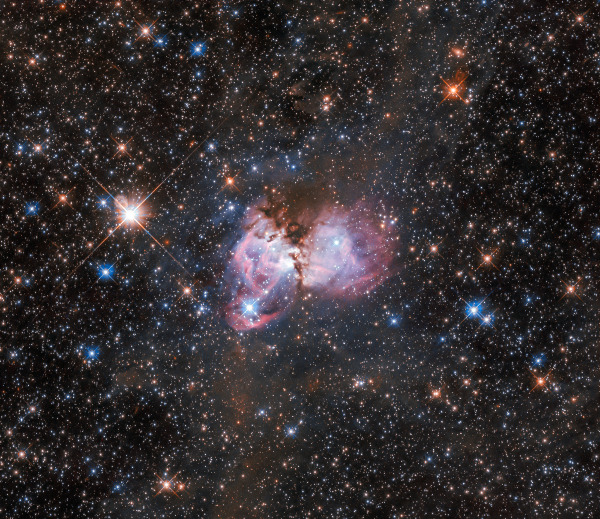On the origin of massive stars [heic2004]
18 March 2020
This scene of stellar creation, captured by the NASA/ESA Hubble Space Telescope, sits near the outskirts of the famous Tarantula Nebula. This cloud of gas and dust, as well as the many young and massive stars surrounding it, is the perfect laboratory to study the origin of massive stars. |
| A massive laboratory. Credit: ESA/Hubble, NASA, I. Stephens, CC BY 4.0 |
The bright pink cloud and the young stars surrounding it in this image taken with the NASA/ESA Hubble Space Telescope have the uninspiring name LHA 120-N 150. This region of space is located on the outskirts of the Tarantula Nebula, which is the largest known stellar nursery in the local Universe. The nebula is situated over 160 000 light-years away in the Large Magellanic Cloud, a neighbouring irregular dwarf galaxy that orbits the Milky Way.
The Large Magellanic Cloud has had one or more close encounters in the past, possibly with the Small Magellanic Cloud. These interactions have caused an episode of energetic star formation in our tiny neighbour – part of which is visible as the Tarantula Nebula.
Also known as 30 Doradus or NGC 2070, the Tarantula Nebula owes its name to the arrangement of bright patches that somewhat resemble the legs of a tarantula. It measures nearly 1000 light-years across. Its proximity, the favourable inclination of the Large Magellanic Cloud, and the absence of intervening dust make the Tarantula Nebula one of the best laboratories in which to study the formation of stars, in particular massive stars. This nebula has an exceptionally high concentration of massive stars, often referred to as super star clusters.
Astronomers have studied LHA 120-N 150 to learn more about the environment in which massive stars form. Theoretical models of the formation of massive stars suggest that they should form within clusters of stars; but observations indicate that up to ten percent of them also formed in isolation. The giant Tarantula Nebula with its numerous substructures is the perfect laboratory in which to resolve this puzzle as in it massive stars can be found both as members of clusters and in isolation.
With the help of Hubble, astronomers try to find out whether the isolated stars visible in the nebula truly formed alone or just moved away from their stellar siblings. However, such a study is not an easy task; young stars, before they are fully formed – especially massive ones – look very similar to dense clumps of dust.
LHA 120-N 150 contains several dozen of these objects. They are a mix of unclassified sources – some probably young stellar objects and others probably dust clumps. Only detailed analysis and observations will reveal their true nature and that will help to finally solve the unanswered question of the origin of massive stars.
Hubble has observed the Tarantula Nebula and its substructures in the past – always being interested in the formation and evolution of stars.
More information
The Hubble Space Telescope is a project of international cooperation between ESA and NASA.
The scientific results of this observation were previously published in the Astrophysical Journal.
Contacts
Bethany Downer
ESA/Hubble, Public Information Officer
Garching, Germany
Email: bethany.downer![]() partner.eso.org
partner.eso.org


